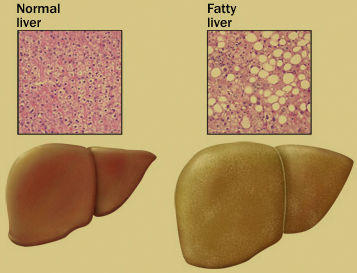As I mentioned in this blog, triglycerides can be made in the liver in response to eating carbohydrate. Fat formed in this way can, after being disassembled, make its way into the fat cells. High levels of the hormone insulin increases the absorption of fat uptake by at cells. So, in short, carbohydrate can stimulate the product of fat in the liver and also enhance the chances of it getting dumped in our fat cells.
However, if the liver makes fat fast enough, there's a risk that it will accumulate in the liver. In time, the results is 'fatty liver' - also known as non-alcoholic fatty liver disease (NAFLD). Further down the track, the liver can become subject to fibrosis and even cirrhosis. Foie gras is fatty liver. What is it that geese are force-fed in order to produce this? The answer is grain (carbohydrate).
What about humans? In one study, the impact of diet on liver function was tested in a group of healthy men and women [1]. The study participants were put on a regime which involved eating two fast-food meals each day for four weeks. Their results were compared with a group of individuals who were not subjected to the regime.
Over the course of the 4-week study, those on the fast-food regime put on an average of about 6.5 kg in weight. In particular, waist size increased significantly. The level of the liver enzyme alanine aminotransferase (ALT) went up from an average of 22.1 U/L (normal) to 97.0 U/L (abnormally raised). This is taken as a sign of liver damage. Not only that, but the fat level in the liver cells of these individuals increased by over 150 per cent (quite a feat in just four weeks).
It looks as though we have evidence here that gorging on fast food turns out to be bad for our weight and liver. But what was interesting about this study is that the authors looked at the relationship between different elements of the diet and changes in ALT levels. In other words, they wanted to see if they could find out what it was about fast food that seemed to have damaged the liver.
The researchers discovered that ALT levels were not related to intakes of fat, protein or total calories, but were associated with carbohydrate intake. The higher the carbohydrate intake, the higher the ALT levels were.
This week saw the publication of a study that further reinforces the idea that carbohydrate can be uniquely bad for the liver.
In this study, 18 obese adults (average age 45 and average BMI 35) were put on one of two diets for a period of two weeks [2]. These were:
1. their usual diet, but calories were restricted to 1200-1500 calories per dayThe study lasted two weeks. At the end of the study period, both groups lost similar amounts of weight (average of 4.0 kg in group in calorie-restricted group compared to 4.6 kg in carb-restricted group).
2. a low carbohydrate diet, limiting carbohydrate to less than 20 g per day, but with no restriction on calorie intake
Both groups saw significant reductions in the amount of fat in their livers.
However, the reduction was about twice as great in the carbohydrate-restricted group (an average of 55 per cent versus 28 per cent in the calorie-restricted group).
One potential reason for this was the fact that the liver was likely to be producing less fat in response to lowered carbohydrate intake. But, is it possible that the body was 'burning' fat more effectively too? It seems so: 'Fat oxidation' was found to be higher in the carbohydrate-restricted group.
One potential explanation for this is that when the liver makes fat, it makes a substance (called malonyl-CoA) which inhibits the transport of fat into the mitochrondria (tiny furnaces in the cells) where they can be metabolised.
Put another way, when carbohydrates are restricted, the liver makes less fat, and this actually allows fat to more readily makes its way into the mitochondria where it can be burned.
Overall, what this study shows that if you want to get rid of excess fat in the liver (or elsewhere, for that matter), probably your best chance of success rests with a diet lower in carbohydrate.
References:
1. Kechagias S, et al. Fast-food-based hyper-alimentation can induce rapid and profound elevation of serum alanine aminotranferase in healthy subjects. Gut 2008;57(5):649-54
2. Browning JD, et al. Short-term weight loss and hepatic triglyceride reduction: evidence of a metabolic advantage with dietary carbohydrate restriction Am J Clin Nutr March 2 2011 [epub before print]




Reader Comments
to our Newsletter